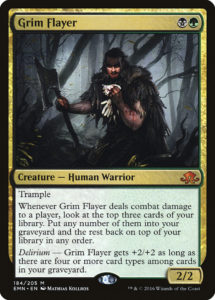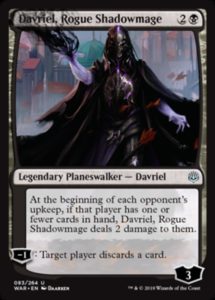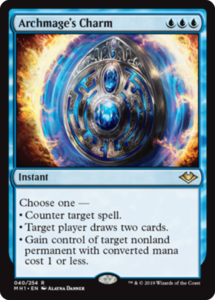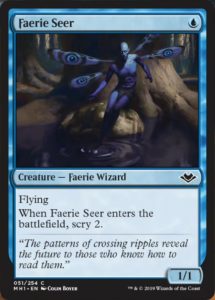Now that Modern Horizon previews have finished, let’s talk more about how to get into Modern. In the first part of this series, I delved into how to approach Modern on a budget and figuring out what archetypes are best suited for you. This week, I continue my crash course for entering Modern. I’ll offer some budget-friendly options that have the potential to be competitive, with an emphasis on upgrading into established archetypes in the future.
Once again, I am writing this from the perspective of a Standard player wanting to make the jump to Modern using the Standard card pool as a foundation for deckbuilding.
Understanding the Format
Modern is an incredibly broad and deep format, with cards added to the pool every couple of months. Admittedly, it’s tough to keep up and can be intimidating, but most of your knowledge will come from playing games. There are myriad archetypes and strategies on offer, far beyond what you’ll see on tournament coverage, so it’s always good to be proactive with playing the format in paper or on Magic Online.
By playing a bunch of games, you’re learning about particular matchups, what to play around, and most importantly how to sideboard. Sideboarding is one of the more difficult aspects of Magic, and you will improve over time as you learn what matters in each matchup. Sideboard guides are a good start, and I recommend using them until you really know what you’re doing. To aid my sideboarding skills, I always make an effort to talk to my opponent post-match about how they sideboarded against me. By doing this, I’m learning more about my match ups and finding out what my opponent sideboarded in and whether it was the correct choice or not. Information is meant to be shared, so it’s always good to be proactive about this in paper Magic. Learning about Modern doesn’t happen overnight; but if you want to play more Modern and enjoy doing so, this will come naturally which will remove any intimidation or concerns that you may have.
There are archetypes which lean on format knowledge more than others, such as Jund and Golgari Midrange (also known as The Rock). These decks have been stalwarts in the Modern landscape for years and remain excellent because of their powerful cards and diverse answers to the Modern metagame. Knowing what to disrupt is key to winning games however, so you need to understand the format to know which cards to play and how to play them. If you are interested in playing a midrange strategy in Modern, be prepared to lose a little to begin with until you become familiar with the format. This is not meant to be discouraging, but these strategies are successful in reflection of the pilot’s knowledge of the format. Eventually, you will identify key cards and their win conditions which will convert into wins down the line.
Building Budget Decks
Both Jund and Golgari Midrange seek to deny their opponent’s resources with discard and removal. Once your opponent is low on resources, you close out the game with powerful creatures that your opponents can’t deal with. This is not a fancy or exceptional strategy, but the deck is efficient and can be adapted in various local metagames. The big downside of these decks? They are incredibly expensive. These strategies range over $1500, which is a tremendous financial commitment if you want a fully optimised build.
Despite this drawback, we can take inspiration from Golgari Midrange in Standard, which presents a similar game plan but with a smaller and more affordable card pool. Let’s use an example which finished second in an SCG Standard Invitational Qualifier in Niles, USA.
Standard Golgari Midrange
| Creatures (22) 4 Merfolk Branchwalker 3 Wildgrowth Walker 4 Seekers’ Squire 4 Jadelight Ranger 1 Golgari Findbroker 2 Thrashing Brontodon 2 Ravenous Chupacabra 2 Carnage Tyrant Spells (13) 1 Assassin’s Trophy 4 Duress 3 Find/Finality 2 Vivien Reid 3 Vraska, Golgari Queen | Lands (25) 9 Forest 2 Memorial to Folly 4 Overgrown Tomb 6 Swamp 4 Woodland Cemetery Sideboard (15) 2 Arguel’s Blood Fast 3 Cast Down 1 Golgari Findbroker 4 Kraul Harpooner 2 Reclamation Sage 3 The Eldest Reborn |
Standard Golgari Midrange offers plenty of comparisons to the Modern variant and adopts a similar game plan. Standard is in a fantastic spot of incorporating powerful cards with an affordable price point. The list above comes to roughly $150 and makes an excellent foundation to upgrade into Budget Golgari Midrange in Modern.
Below is my take on Budget Golgari Midrange in Modern, which can compete reasonably at FNMs. This list incorporates current Standard cards as well as echoes from an old Standard strategy in Golgari Delirium, and costs roughly $170.
Budget Modern Golgari Midrange
I’ve omitted the Red from full Jund—the splash is not worth exploring until you have optimized this build. Golgari Midrange is better situated in the current Modern metagame as life resource management is key in the aggressive metagame. As a result, Golgari Midrange has a more streamlined land base to reflect this. However, I recommend fully upgrading Golgari Midrange first before considering the Red splash. This means you have a complete deck, and can look at other options down the line.

Golgari Delirium was a powerhouse in Standard of old and takes advantage of your graveyard. Grim Flayer is an excellent means of card filtering that becomes a big threat late-game, and Traverse the Ulvenwald provides flexibility throughout all courses of the game. Admittedly this isn’t Modern Golgari Midrange in the traditional sense—the flagship cards such as Liliana of the Veil and Tarmogoyf are difficult to fully replicate at a budget level given how unique they are. Despite this, War of the Spark has provided us with some excellent Planeswalkers which trade power for a lower price point.

Davriel, Rogue Shadowmage makes a decent imitation of Liliana of the Veil. It also compliments the Delirium subtheme as well as tying in the resource-denial gameplan. Tarmogoyf is an excellent finisher in optimal Jund and Golgari Rock lists, but it remains expensive despite its low impact in Modern currently. I chose Thorn Lieutenant as a budget alternative because it two-for-ones your opponent and you can sink mana late. You could also run Growth-Chamber Guardian or Merfolk Branchwalker to feed the graveyard for Delirium too.
Recent Standard sets have supplied us with the bulk of this list. Fatal Push, Grim Flayer, and Traverse the Ulvenwald are all excellent additions and affordable to pick up. Recent supplemental sets have lowered the prices of Abrupt Decay, Maelstrom Pulse, and Inquisition of Kozilek as well.
If you’re already running an optimal Golgari Midrange in Standard, Assassin’s Trophy is an excellent addition to this list and should replace an Abrupt Decay and the Cast Downs. Over time, you will want to upgrade into Thoughtseize, Collective Brutality, and Blooming Marsh to begin with.
It’s important to pick up your cheaper upgrades first as it will improve the overall performance of your deck, instead of upgrading into one very expensive card. I suggest upgrading into Liliana of the Veil, Tarmogoyf, Dark Confidant, and Verdant Catacombs last. These will take more time to obtain if you are on a budget, and it’s important to grab the cheaper cards first as this will improve your deck the most.

Deviating from midrange strategies, I want to focus on one of the most affordable Standard decks around. Mono-Blue Tempo is a fantastic example of how money doesn’t equate to success, as Autumn Burchett proved when they took down Mythic Championship II London earlier in the year. Despite the affordable price tag, Mono-Blue Tempo requires a certain amount of skill to play well and navigating the mirror can be tough.
We can upgrade Mono-Blue Tempo into a Mono-Blue Delver strategy for Modern. My list of upgrades comes to roughly around $140, but this can be achieved under $100 by removing Commandeer and Vedalken Shackles.
Budget Mono-Blue Delver
| Creatures (14) 4 Delver of Secrets 4 Spellstutter Sprite 4 Pteramander 2 Tempest Djinn Spells (28) 2 Mana Leak 4 Opt 1 Psionic Blast 3 Remand 4 Serum Visions 2 Spell Pierce 3 Think Twice 4 Thought Scour 3 Vapor Snag 2 Dismember | Lands (18) 3 Faerie Conclave 15 Island Sideboard (15) 1 Ashiok, Dream Render 1 Commandeer 1 Dismember 2 Echoing Truth 2 Narset’s Reversal 1 Ratchet Bomb 1 Repeal 2 Saheeli, Sublime Artificer 2 Tormod’s Crypt 2 Vedalken Shackles |
Mono-Blue Delver has been a well-loved budget Modern strategy for years. It transitions well from Standard Mono Blue, though you have to increase the instants and sorceries to guarantee Delver of Secrets will flip. Most of the upgrades are strict improvements on the Standard version. However, I’d recommend trying to fit a handful of Dive Downs if you’re short on instants.
I’ve gone for a Faerie subtheme by adding Faerie Conclave because Spellstutter Sprite supplies excellent tempo in the build. Extending this, there is an option to expand into Mono-Blue Faeries with Mistbind Clique and Vendilion Clique for additional tempo. There’s also a new one-mana Faerie in Modern Horizons:

If you want to go down the Mono-Blue Faerie route, I recommend adding Faerie Seer to the list once Modern Horizons is released. It’s cheap, evasive, sets up your next draw and can be convincing if enchanted with Curious Obsession. If you choose to opt out on Mono-Blue Faeries, you can upgrade Mono-Blue Delver with Snapcaster Mages and Cryptic Commands. The price jump is substantial, but these Modern staples will see play outside of this archetype and serve you well for years. Alternatively, Archmage’s Charm from Modern Horizons could fit into a Mono-Blue strategy and could be a budget alternative to Cryptic Command, but it’s hard to tell the price until the set is released.
We are seeing powerful cards making an impression all across Standard in recent years, which means some of them will make their way to Modern as well. Over time you can accrue a Modern collection through playing Standard, which allows your cards to go further. The bridge between the two formats has never been easier. In addition, Modern Horizons is looking to boost fringe and tribal strategies, which may give birth to more budget options in the future. I’m excited to get my hands on Modern Horizons and see what budget brews I can build!
Emma is a writer and Modern enthusiast based in Suffolk, England. She has been involved in Magic since Khans of Tarkir’s release back in 2014, but won’t shy away from Cube and MTG Arena. Follow her on Twitter @emmmzyne to join in on the conversation!

